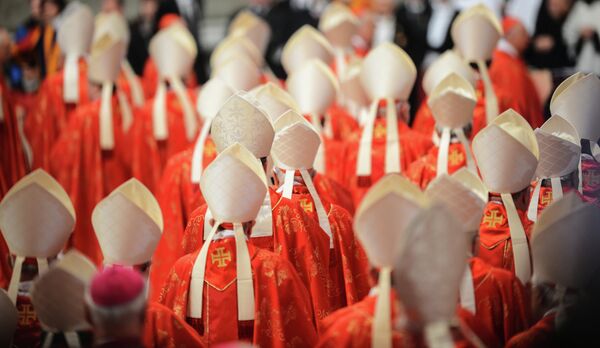VATICAN, March 12 (RIA Novosti) – The Roman Catholic Church’s 115 cardinals locked themselves inside the Sistine Chapel on Tuesday after hours of prayers to elect their 226th leader.
As Guido Marini, the master of papal liturgical celebrations, cried “extra omnes,” meaning “everyone out,” staff and reporters left the chapel and the first conclave in modern history, which is held after the pontiff’s resignation and not death, began behind locked doors.
Pope Benedict XVI, who became the 265th Pope in 2005 following his predecessor John Paul II’s death, announced his resignation due to old age and failing health on February 11. The last pope to step down before his death was Gregory XII in 1415.
Under church rules, the winning candidate must get a two-thirds majority, or 77 votes. The election process will take as many days as necessary to achieve an absolute majority winner.
The front-runners to succeed Pope Benedict XVI, according to Vatican officials and bookmakers, appear to be Cardinals Angelo Scola of Italy, Odilio Scherer of Brazil, Marc Ouellet of Canada and Peter Turkson of Ghana.
The cardinals were not required to vote on Tuesday, the first day of the conclave, but they did. Each cardinal had to clearly write a candidate’s name on a rectangular ballot reading “Eligo in Summum Pontificem” or “I elect as supreme pontiff” and place his vote into a special urn. The ballots were counted, pierced and strung on a thread.
The ballots were then burned in a furnace with special chemicals to turn the smoke white or black, depending on the result. If the voting had been successful, white smoke and the tolling of a bell would have given the faithful a signal that they have a new pope.
However, by about 7:30 p.m. local time, those who had gathered in St. Peter’s Square under pouring rain Tuesday saw black smoke coming from the chimney of the Sistine Chapel, indicating that the conclave of cardinals had failed to elect their new leader.
Beginning Wednesday, the cardinals will vote four times a day, twice in the morning and twice in the afternoon, until a new leader of the Roman Catholic Church is elected.
Recasts paragraphs 6-8, adds information about the first vote for pope.


